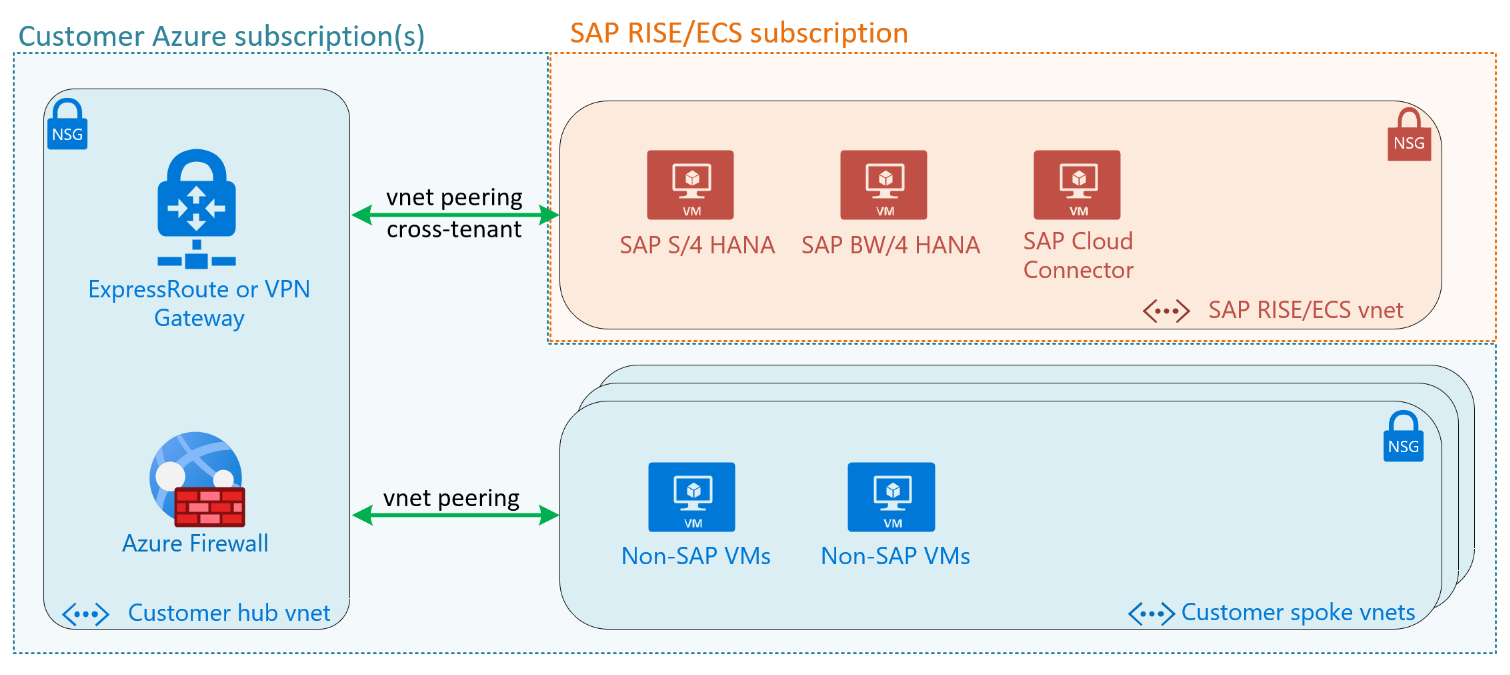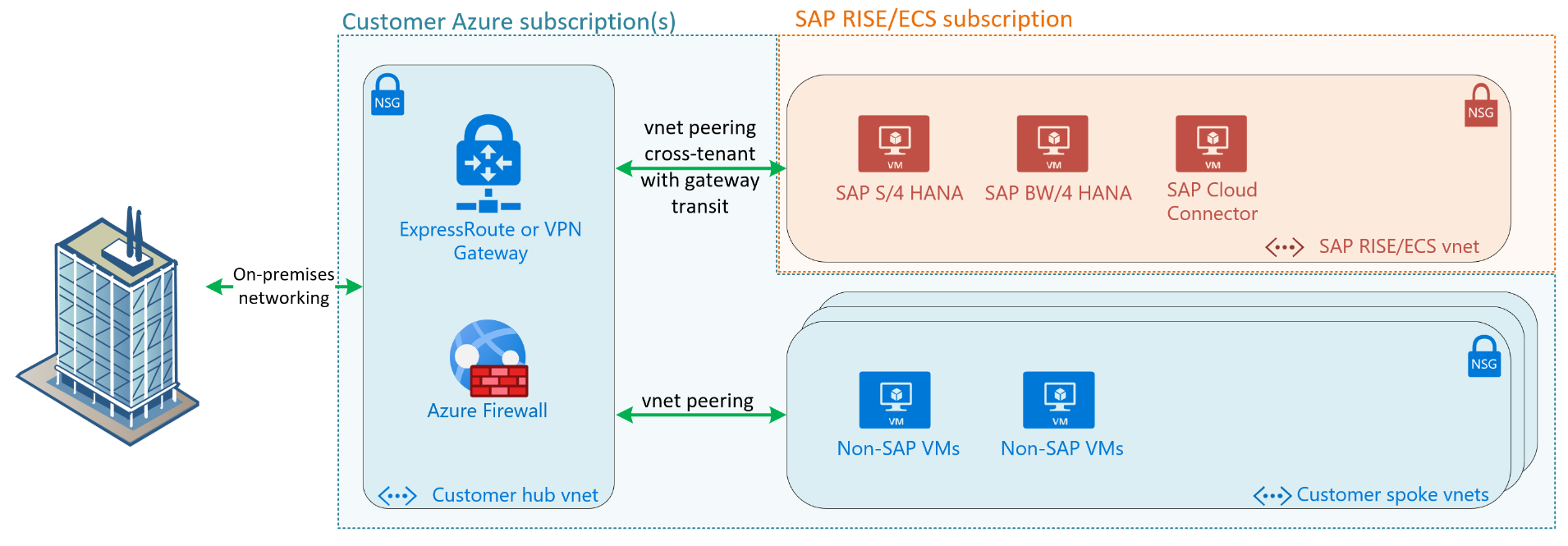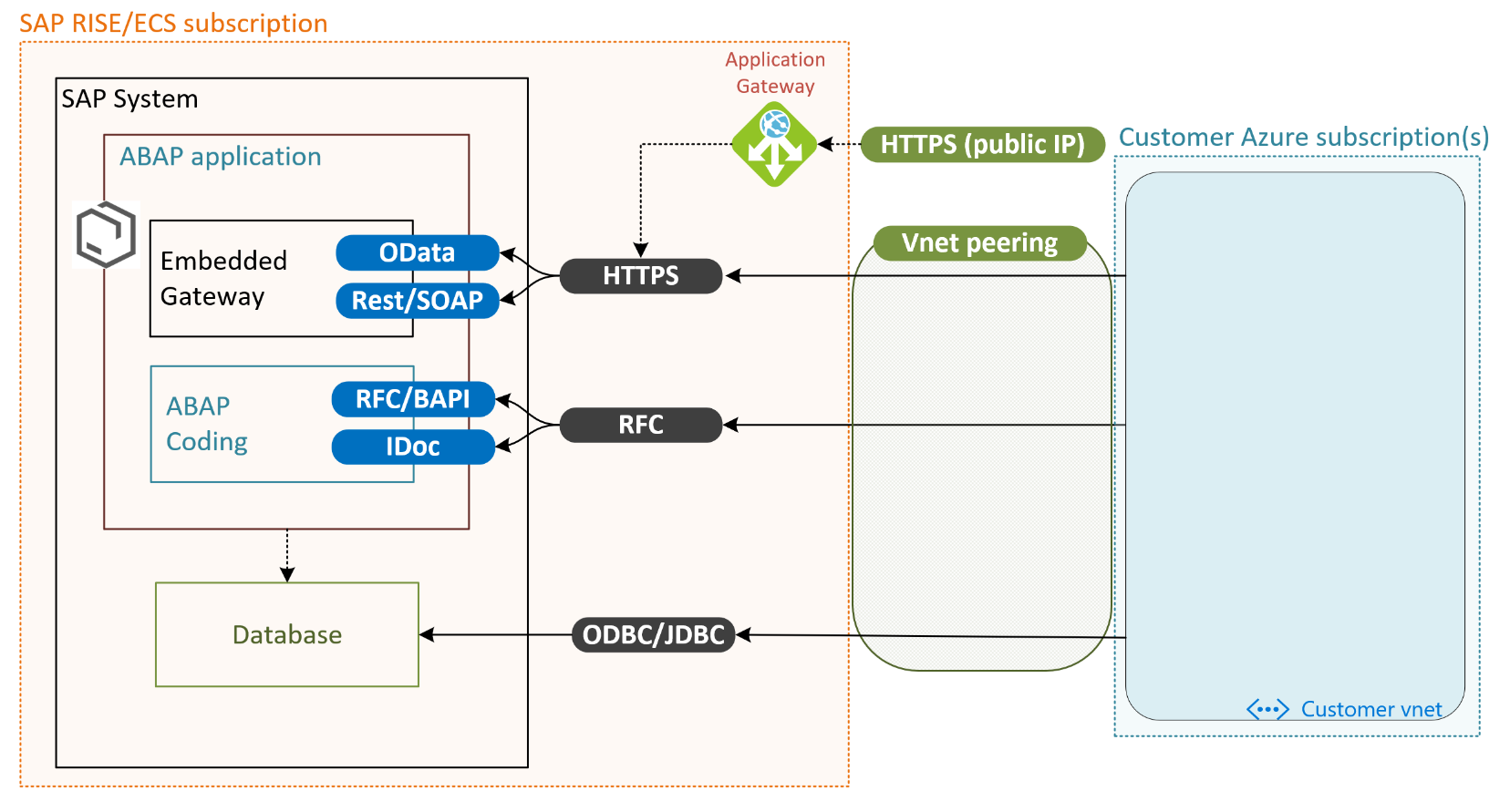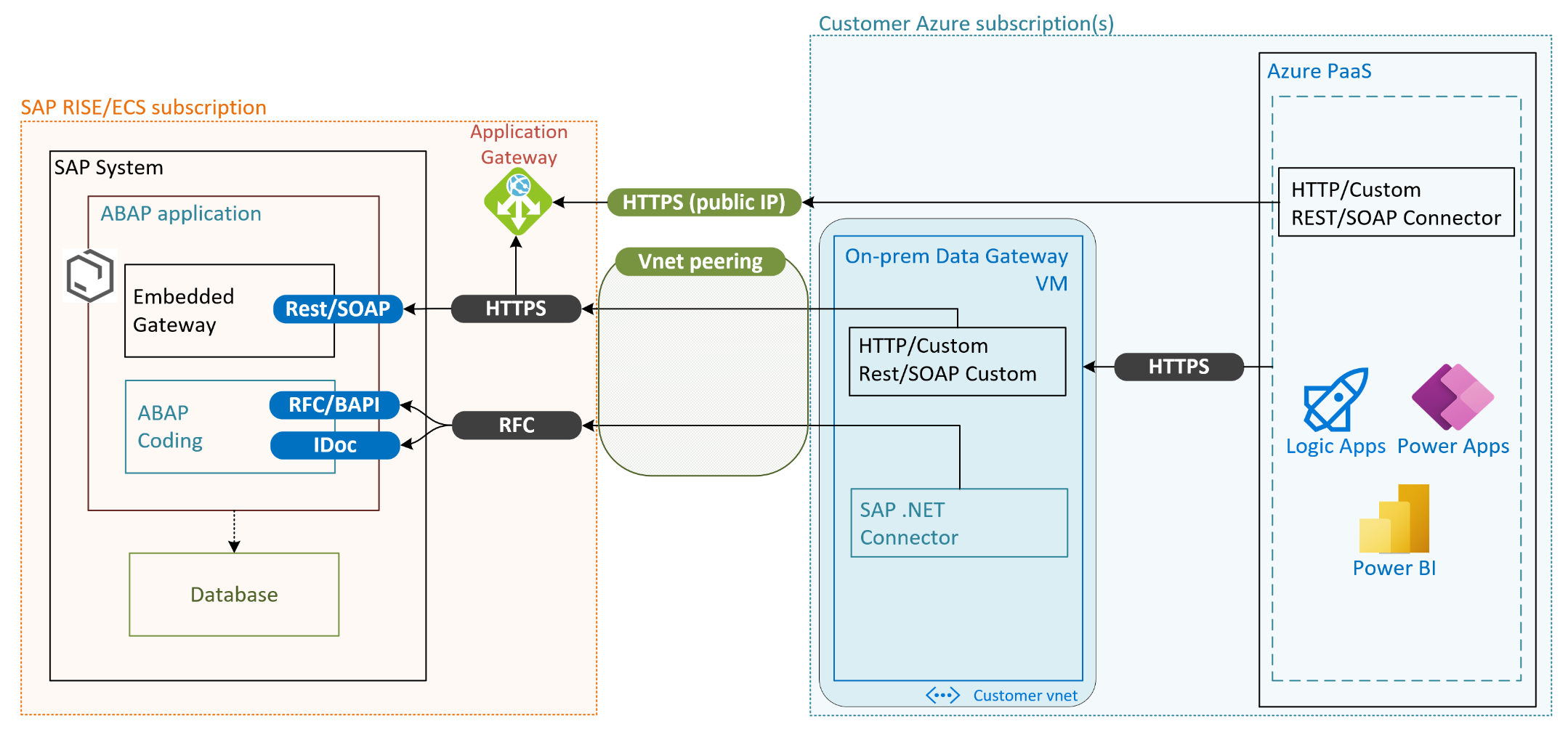This For customers with SAP solutions such as RISE with SAP Enterprise Cloud Services (ECS) and SAP S/4HANA Cloud, private edition (PCE) which are deployed on Azure, integrating the SAP managed environment with their own Azure ecosystem and third party application
Below are the different scenarios
Virtual network peering with SAP RISE/ECS
A vnet peering is the most performant way to connect securely and privately two standalone vnets, utilizing the Microsoft private backbone network. The peered networks appear as one for connectivity purposes, allowing applications to talk to each other. Applications running in different vnets, subscriptions, Azure tenants or regions are enabled to communicate directly. Like network traffic on a single vnet, vnet peering traffic remains on Microsoft’s private network and doesn’t traverse the internet.
For SAP RISE/ECS deployments, virtual peering is the preferred way to establish connectivity with customer’s existing Azure environment. Both the SAP vnet and customer vnet(s) are protected with network security groups (NSG), enabling communication on SAP and database ports through the vnet peering. Communication between the peered vnets is secured through these NSGs, limiting communication to customer’s SAP environment. For details and a list of open ports, contact your SAP representative.
SAP managed workload is preferably deployed in the same region as customer’s central infrastructure and applications accessing it. Virtual network peering can be set up within the same region as your SAP managed environment, but also between any two Azure regions. With SAP RISE/ECS available in many Azure regions, the region ideally should be matched with workload running in customer vnets due to latency and vnet peering cost considerations. However, some of the scenarios (for example, central S/4HANA deployment for a multi-national, globally presented company) also require to peer networks globally.

This diagram shows a typical SAP customer’s hub and spoke virtual networks. Cross-tenant virtual network peering connects SAP RISE vnet to customer’s hub vnet.
Since SAP RISE/ECS runs in SAP’s Azure tenant and subscriptions, the virtual network peering needs to be set up between different tenants. This can be accomplished by setting up the peering with the SAP provided network’s Azure resource ID and have SAP approve the peering. A. Contact your SAP representative for the exact steps required. Engage the respective team(s) within your organization that deal with network, user administration and architecture to enable this process to be completed swiftly.
VPN Vnet-to-Vnet
As an alternative to vnet peering, virtual private network (VPN) connection can be established between VPN gateways, deployed both in the SAP RISE/ECS subscription and customers own. A vnet-to-vnet connection will be established between these two VPN gateways, enabling fast communication between the two separate vnets. The respective vnets and gateways can be located in different Azure regions.

This diagram shows a typical SAP customer’s hub and spoke virtual networks. VPN gateway located in SAP RISE vnet connects through vnet-to-vnet connection into gateway contained in customer’s hub vnet.
While vnet peering is the recommended and more typical deployment model, a VPN vnet-to-vnet can potentially simplify a complex virtual peering between customer and SAP RISE/ECS virtual networks. The VPN Gateway acts as only point of entry into the customer’s network and is managed and secured by a central team.
Network Security Groups are in effect on both customer and SAP Vnet, identically to vnet peering architecture enabling communication to SAP NetWeaver and HANA ports as required. For details how to set up the VPN connection and which settings should be used, contact your SAP representative.
Connectivity back to on-premises
With an existing customer Azure deployment, on-premises network is already connected through ExpressRoute (ER) or VPN. The same on-premises network path is typically used for SAP RISE/ECS managed workloads. Preferred architecture is to use existing ER/VPN Gateways in customer’s hub vnet for this purpose, with connected SAP RISE vnet seen as a spoke network connected to customer’s vnet hub.

This diagram shows a typical SAP customer’s hub and spoke virtual networks. It’s connected to on-premises with a connection. Cross tenant virtual network peering connects SAP RISE vnet to customer’s hub vnet. The vnet peering has remote gateway transit enabled, enabling SAP RISE vnet to be accessed from on-premises.
With this architecture, central policies and security rules governing network connectivity to customer workloads also apply to SAP RISE/ECS managed workloads. The same on-premises network path is used for both customer’s vnets and SAP RISE/ECS vnet.
If there’s no currently existing Azure to on-premises connectivity, Any on-premises to SAP RISE/ECS connection is then for reaching the SAP managed vnet only. The on-premises to SAP RISE/ECS connection isn’t used to access customer’s own Azure vnets.
Important to note: A virtual network can have local or remote gateway With vnet peering established between SAP RISE/ECS using remote gateway transit like in above architecture, no gateways can be added in the SAP RISE/ECS vnet. A combination of vnet peering with remote gateway transit together with another VPN gateway in the SAP RISE/ECS vnet isn’t possible.
Virtual WAN with SAP RISE/ECS managed workloads
Similarly to using a hub and spoke network architecture with connectivity to both SAP RISE/ECS vnet and on-premises, the Azure Virtual Wan (vWAN) hub can be used for same purpose. Both connection options described earlier – vnet peering as well as VPN vnet-to-vnet – are available to be connected to vWAN hub.
The vWAN network hub is deployed and managed entirely by customer in customer subscription and vnet. On-premise connection and routing through vWAN network hub are also managed entirely by customer.
Again, contact your SAP representative for details and steps needed to establish this connectivity.
SAP BTP Connectivity
SAP Business Technology Platform (BTP) provides a multitude of applications that are mostly accessed by public IP/hostname via the Internet. Customer services running in their Azure subscriptions access them either directly through VM/Azure service internet connection, or through User Defined Routes forcing all Internet bound traffic to go through a centrally managed firewall or other network virtual appliances. Few SAP BTP services, such as SAP Data Intelligence, however is by design accessed through a separate vnet peering instead of a public endpoint typically used for BTP application.
SAP offers Private link Service for customers using SAP BTP on Azure. The SAP Private Link Service connects SAP BTP services through a private IP range into customer’s Azure network and thus accessible privately through the private link service instead of through the Internet. Contact SAP for availability of this service for SAP RISE/ECS workloads.
Virtual network peering with SAP RISE/ECS
A vnet peering is the most performant way to connect securely and privately two standalone vnets, utilizing the Microsoft private backbone network. The peered networks appear as one for connectivity purposes, allowing applications to talk to each other. Applications running in different vnets, subscriptions, Azure tenants or regions are enabled to communicate directly. Like network traffic on a single vnet, vnet peering traffic remains on Microsoft’s private network and doesn’t traverse the internet.
For SAP RISE/ECS deployments, virtual peering is the preferred way to establish connectivity with customer’s existing Azure environment. Both the SAP vnet and customer vnet(s) are protected with network security groups (NSG), enabling communication on SAP and database ports through the vnet peering. Communication between the peered vnets is secured through these NSGs, limiting communication to customer’s SAP environment. For details and a list of open ports, contact your SAP representative.
SAP managed workload is preferably deployed in the same region as customer’s central infrastructure and applications accessing it. Virtual network peering can be set up within the same region as your SAP managed environment, but also through global virtual network peering between any two Azure regions. With SAP RISE/ECS available in many Azure regions, the region ideally should be matched with workload running in customer vnets due to latency and vnet peering cost considerations. However, some of the scenarios (for example, central S/4HANA deployment for a multi-national, globally presented company) also require to peer networks globally.

This diagram shows a typical SAP customer’s hub and spoke virtual networks. Cross-tenant virtual network peering connects SAP RISE vnet to customer’s hub vnet.
Since SAP RISE/ECS runs in SAP’s Azure tenant and subscriptions, the virtual network peering needs to be set up between different tenants. This can be accomplished by setting up the peering with the SAP provided network’s Azure resource ID and have SAP approve the peering. Add a user from the opposite AAD tenant as a guest user,
VPN Vnet-to-Vnet
As an alternative to vnet peering, virtual private network (VPN) connection can be established between VPN gateways, deployed both in the SAP RISE/ECS subscription and customers own. A vnet-to-vnet connection will be established between these two VPN gateways, enabling fast communication between the two separate vnets. The respective vnets and gateways can be located in different Azure regions.

This diagram shows a typical SAP customer’s hub and spoke virtual networks. VPN gateway located in SAP RISE vnet connects through vnet-to-vnet connection into gateway contained in customer’s hub vnet.
While vnet peering is the recommended and more typical deployment model, a VPN vnet-to-vnet can potentially simplify a complex virtual peering between customer and SAP RISE/ECS virtual networks. The VPN Gateway acts as only point of entry into the customer’s network and is managed and secured by a central team.
Network Security Groups are in effect on both customer and SAP vnet, identically to vnet peering architecture enabling communication to SAP NetWeaver and HANA ports as required.
Connectivity back to on-premises
With an existing customer Azure deployment, on-premises network is already connected through ExpressRoute (ER) or VPN. The same on-premises network path is typically used for SAP RISE/ECS managed workloads. Preferred architecture is to use existing ER/VPN Gateways in customer’s hub vnet for this purpose, with connected SAP RISE vnet seen as a spoke network connected to customer’s vnet hub.

This diagram shows a typical SAP customer’s hub and spoke virtual networks. It’s connected to on-premises with a connection. Cross tenant virtual network peering connects SAP RISE vnet to customer’s hub vnet. The vnet peering has remote gateway transit enabled, enabling SAP RISE vnet to be accessed from on-premises.
With this architecture, central policies and security rules governing network connectivity to customer workloads also apply to SAP RISE/ECS managed workloads. The same on-premises network path is used for both customer’s vnets and SAP RISE/ECS vnet.
If there’s no currently existing Azure to on-premises connectivity, contact your SAP representative for details which connections models are possible to be established. Any on-premises to SAP RISE/ECS connection is then for reaching the SAP managed vnet only. The on-premises to SAP RISE/ECS connection isn’t used to access customer’s own Azure vnets.
Important to note: A virtual network can have only one gateway local or remote. With vnet peering established between SAP RISE/ECS using remote gateway transit like in above architecture, no gateways can be added in the SAP RISE/ECS vnet. A combination of vnet peering with remote gateway transit together with another VPN gateway in the SAP RISE/ECS vnet isn’t possible.
Virtual WAN with SAP RISE/ECS managed workloads
Similarly to using a hub and spoke network architecture with connectivity to both SAP RISE/ECS vnet and on-premises, the Azure Virtual Wan (vWAN) hub can be used for same purpose. Both connection options described earlier – vnet peering as well as VPN vnet-to-vnet – are available to be connected to vWAN hub.
The vWAN network hub is deployed and managed entirely by customer in customer subscription and vnet. On-premise connection and routing through vWAN network hub are also managed entirely by customer.
Again, contact your SAP representative for details and steps needed to establish this connectivity.
Integration with Azure services
For SAP Fiori, standalone or embedded within the SAP S/4 HANA or NetWeaver system, the customer can connect applications through OData or REST API. Both use https for incoming requests to the SAP system. Applications running on-premises or within the customer’s own Azure subscription and vnet, use the established vnet peering or VPN vnet-to-vnet connection through a private IP address. Applications accessing a publicly available IP, exposed through SAP RISE managed Azure application gateway, are also able to contact the SAP system through https
Applications using remote function calls (RFC) or direct database connections using JDBC/ODBC protocols are only possible through private networks and thus via the vnet peering or VPN from customer’s vnet(s).

Integration with self-hosted integration runtime
Integrating your SAP system with Azure cloud native services such as Azure Data Factory or Azure Synapse would use these communication channels to the SAP RISE/ECS managed environment.

On – Premises data gateway
Further Azure Services such as Logic Apps , Power BI communicate and exchange data with SAP systems through an on-premises data gateway. The on-premises data gateway is a virtual machine, running in Azure or on-premises. It provides secure data transfer between these Azure Services and your SAP systems.
With SAP RISE, the on-premises data gateway can connect to Azure Services running in customer’s Azure subscription. This VM running the data gateway is deployed and operated by the customer. With below high-level architecture as overview, similar method can be used for either service.

The SAP RISE environment here provides access to the SAP ports for RFC and https described earlier. The communication ports are accessed by the private network address through the vnet peering or VPN site-to-site connection.
The on-premises data gateway VM running in customer’s Azure subscription uses the .NET Connector to run RFC, BAPI or IDoc calls through the RFC connection. Additionally, depending on service and way the communication is setup, a way to connect to public IP of the SAP systems REST API through https might be required. The https connection to a public IP can be exposed through SAP RISE/ECS managed application gateway
Conclusion
For customers with SAP solutions such as RISE with SAP Enterprise Cloud Services (ECS) and SAP S/4HANA Cloud, private edition (PCE) which are deployed on Azure, integrating the SAP managed environment with their own Azure ecosystem and third party applications is of particular importance. The following article explains the concepts utilized and best practices to follow for a secure and performant solution.
References
Integrating Azure with SAP RISE managed workloads – Azure Virtual Machines | Microsoft Docs

